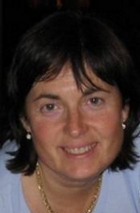Eculizumab in Infants
 Complement cascade inhibition has revolutionized treatment of atypical hemolytic uremic syndrome (aHUS). A recent case report published in the American Journal of Kidney Diseases reports the youngest infant to be treated with eculizumab. Corresponding author Dr. Gema Ariceta (GA) discusses this case with Dr. Sidharth Sethi (eAJKD), pediatric nephrologist and eAJKD advisory board member.
Complement cascade inhibition has revolutionized treatment of atypical hemolytic uremic syndrome (aHUS). A recent case report published in the American Journal of Kidney Diseases reports the youngest infant to be treated with eculizumab. Corresponding author Dr. Gema Ariceta (GA) discusses this case with Dr. Sidharth Sethi (eAJKD), pediatric nephrologist and eAJKD advisory board member.
eAJKD: Could you describe your case of the youngest infant treated with eculizumab?
GA: The patient was a 28-day-old infant with aHUS. Diagnosing aHUS at such a young age is very difficult. Infusion of a large volume of plasma was tried, but resulted in volume overload, progressive kidney injury, and uncontrolled aHUS. We next attempted plasma exchange, which was a technical challenge to perform. Slowly, he became sicker requiring mechanical ventilation and continuous forms of renal replacement therapy. As a final attempt, we administered the drug eculizumab. Within one day of treatment, the patient started urinating and the hemolysis stopped completely. He made a full recovery, and now, at the age of 17 months, is still doing well on eculizumab treatment. In the course of his disease, he had one episode of minor relapse.
eAJKD: Do you think this patient had an acquired form or an inherited form of aHUS?
GA: We believe he has complement dysregulation of the alternative pathway. As he was a newborn at presentation, ADAMTS13 deficiency was excluded. We also excluded etiologies such as HIV and cobalamin defect. After identifying accelerated alternative complement dysregulation, we sent the patient’s blood samples to a special laboratory in Madrid where an international group of experts in complement and HUS tested the samples for different complement gene defects such as factor I, H, membrane cofactor protein, C3, and factor B. No mutations were found. This is not unusual as almost 40% of these patients have no mutations identified. Our patient does have a low C3 and normal C4 suggesting complement dysregulation. Both his parents and sibling appear healthy with no defect in complement regulators.
eAJKD: Can you describe how you got the pharmacokinetics done to exactly decide the dose of eculizumab for this patient?
GA: There is no experience dosing this drug in patients who weigh less than 5 kg. Hence, we drew blood for pharmacokinetic studies with the help of the pharmaceutical company that makes the drug. This patient received 300 mg of eculizumab every 30 weeks.
eAJKD: What are your recommendations for treatment of aHUS?
GA: The current standard of care is based heavily on large-volume plasma exchange. However, in children, we know that there are many technical challenges with performing plasma exchange, and sometimes it’s simply impossible. For these very small children, eculizumab should be considered first. In larger children who can be treated with plasma exchange, treatment with eculizumab may also be considered, although drug availability may be an issue. Also, those pediatric patients who are plasma-exchange dependent did very well with eculizumab. There is an ongoing pediatric clinical trial using eculizumab in patients with aHUS that should shed more light on this question, but other factors like cost and availability of eculizumab may play a role.
eAJKD: What are your thoughts on the recent E coli outbreak in Germany, and how it has helped in our understanding of this disease?
GA: The outbreak in Germany has given us a lot of information about eculizumab. By now, the scientific community has recognized that eculizumab may be useful in very severe aHUS presentations. By carefully reviewing the data from the German outbreak, we may gain insight in its use in typical HUS.
eAJKD: Suppose a child presents with aHUS and is not dialysis dependent? Should plasmapheresis be used?
GA: In a non-dialysis dependent patient who has a very active disease, treatment has to be fast and plasma exchange or eculizumab are options. In an infant in whom plasma exchange may be very difficult, I would recommend using eculizumab. For older children, eculizumab might also be best option, but I am aware of patients that have been successfully treated with plasma exchange. What is very important is that the child be transferred to a center with experience in the disease because I think this is fundamental for prognosis and better clinical outcome.
To view the article abstract or full-text (subscription required), please visit AJKD.org.

Leave a Reply